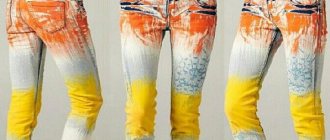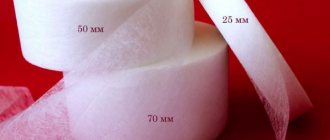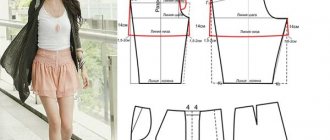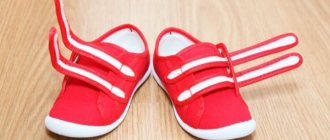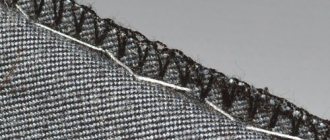Classic pants
Classic models - men's, women's or children's - are lengthened using similar techniques.
The simplest method is when the depth of the hem allows you to add length without the use of other materials. If you need to lengthen the trousers by 1-2 cm, you can open the seam along the bottom edge, iron it, and mark a new hem line.
In men's models, a lapel is often found. This also simplifies the task. Before lengthening, you must carefully - using a seam ripper, a knife or nail scissors - rip the bottom seam and the seams of the trouser tape (if any). It protects the bottom of the product from abrasion. If there is no trouser tape, it is advisable to sew it on.
The thickened edge of the braid should be at the bottom. For grinding you need:
- mark a line on the wrong side of the fabric;
- measure the width of the braid and place it above the hem line;
- Sew a seam along the top edge to secure the trouser tape;
- iron the lower parts of the trouser legs so that only the thickened roll is visible from under the hem;
- Hem the trousers using a machine or with a blind seam by hand.
The color of the trouser tape must exactly match the shade of the fabric.
Algorithm for lengthening trousers:
- 1. Carefully open the hem seam. Remove the tape.
- 2. Using a sewing needle, remove any remaining thread.
- 3. Iron open seam lines.
- 4. Measure the width of the trouser legs (it will be different in the front and back).
- 5. Use scraps of fabric to create a pattern for the hem pieces. Mark the width (separately for the back and front halves) and length (for the inner hem 2.5-3 cm). Take seam allowances into account.
- 6. Cut out the details.
- 7. Stitch the side parts of the parts. Press the seams.
- 8. Sew the parts to the product using a basting stitch.
- 9. Machine stitch the intended seam. If you don't have a sewing machine, you can use a hand-stitched backstitch.
- 10. Iron the seam through an ironing iron (gauze).
- 11. Mark a line for sewing the trouser tape and stitch it.
- 12. Hem the trousers using a basting stitch or tailor's pins.
- 13. Iron the hem.
- 14. Along the top hem line, sew a machine stitch in increments of at least 2.5 mm or a hand-blind stitch.
- 15. Iron the hem.
If you have scraps of the same fabric from which the product is made, you can make an addition in the form of a lapel. It can be simple or double. To cut out a part, the height of the lapel is added to the hem size (from 3 to 5 cm in finished form on classic models).
To lengthen using a lapel you need:
- on both sides of the trouser legs, open the side seam by 1-2 cm;
- Sew cuff details to the bottom edges of the trousers;
- iron the seams;
- fold the free edge of the parts inward and stitch to the trouser legs;
- iron the cuffs and sew the side seams;
- It is advisable to strengthen the details of the cuffs on the wrong side with an adhesive pad.
Each operation must be accompanied by ironing, only in this case the result will be impeccable. All details are cut out using a shared thread !
Exceptions are models cut on the bias.
Increasing trousers size
The easiest way is to keep the hem to a minimum.
Operating procedure:
- It is necessary to open the seam that secures the hem. The work is done from the wrong side, carefully cutting the threads without damaging the material.
- Threads are removed from the front and back sides of the trousers.
- The lapel is straightened, the fabric is carefully ironed, if necessary, using steam, trying to ensure that the mark from the lapel ceases to remain noticeable.
- The new length of the jeans is applied to the fabric with chalk or soap.
- The cut of the material is processed. To do this, you can make a special seam or sew on a trouser braid.
- The processed bottom of the trouser leg is folded to the intended length, and the resized hem is sewn on.
The panels lengthen the pants, adding more centimeters than the cuff. This work is more painstaking and requires suitable material. You can use lace or even multi-colored cotton fabric as inserts.
Operating procedure:
- The side seam of the trouser leg is ripped out.
- A line of inserts is outlined on the jeans.
- The pant leg is carefully cut to add the insert.
- An insert of the required size is cut from the additional material. The width should match the width of the opened trouser leg.
- The insert is sewn to each part of the leg, below and above the slit. The edges of the seams are processed.
- After ironing the trouser leg, a side seam is sewn.
- The same work is done on the second leg.
We suggest you familiarize yourself with Eliminating urine odor from carpet. How to remove urine smell from carpet
Cuff
Using an insert at the bottom of the trousers, you can not only lengthen them, but also add an additional finishing element to the trousers - a cuff. This will give your usual pants a new look.
The work can be done in several ways.
To prevent the pants from chafing in the groin, you can sew in a gusset. A gusset is a piece of fabric sewn in at the intersection of the side and crotch seams. The gusset is usually placed on home pants (tights or sweatpants, for example) or on children's clothes. Such trousers become much stronger, since there is no weak point where many seams come together. How to sew a gusset into pants:
- Cut out the gusset itself from a plain material. In most cases, this is a rhombus 20-25 cm long and 4-7 cm wide. Sizes must be selected based on the current situation.
- Open the crotch seam to a length slightly less than the length of the gusset.
- Baste or pin the gusset on one side, then machine sew with an inside seam.
- Perform the same operation on the other side of the gusset.
It is important to understand that the above describes the least labor-intensive way to sew a gusset, suitable for pants with a simple cut. To carry out the same procedure with trousers with a complex design, you cannot do without a competent pattern: on different models there are quite a lot of differences, both in size and in the location of the seams.
On classic-fit trousers with a grosgrain, you need to get to the inner seam. To do this, the tape is ripped open, and underneath there is a seam that passes from the main fabric to the waist part.
- Measure out the portion of the allowance needed to increase the size and make a mark with chalk.
- From the mark, lay a new seam going to the existing one.
- After this, you can rip out the old seam. The place where the old seam was must be completely cleared of threads and ironed.
- All that remains is to sew part of the inner bodice in place. Thus, the waist part of the trousers will become one size wider.
To increase the size of trousers at the hips or in the groin area, sew in panels or gussets as described above.
If your trousers have become so small that you can't wear them, you'll have to do a lot of work to get them back into shape. Open the waistband and open the side seams. Insert stripes into the side slits, and sew the belt according to the new dimensions of the product. If you don’t have denim, then take any beautiful fabric, you’ll get a new model.
You can sew a rectangle, a wedge of knitwear into the waistband of your trousers, or even replace the belt with an elastic band, a scarf, or any other element.
You can insert a rectangular fragment like this:
- Undo the loop.
- Cut the belt under the loop.
- Sew in our rectangle as discreetly as possible.
- Sew the loop in place.
Wedges must be cut from elastic stretch fabric. They can be placed along the side seams of the waistband. This is done like this:
- Mark a side seam line on both sides of the waistband.
- Carefully steam out the belt in these places.
- Cut according to the markings.
- We baste the insert in the right place.
- We measure the model.
- We sew and process the seam.
- Sew the belt back to its original place.
For wedge-shaped inserts, any materials that match in color and texture are suitable. Women's models can be decorated with thick lace or bright colored patches.
As a last resort, we completely remove the belt and attach the original silk scarf in its place, placing the ties to the zipper. A good option would be knitted elastic with laces.
Using allowances you can increase your trousers by 1 size. As a rule, when sewing pants, a small amount of fabric is left at the seams. It can be used to position your pants at your hips, waist, calves and legs. To do this, you need to rip out all the seams and sew them again, only reducing the stock.
How to add length to jeans
Is it possible to dye trousers at home?
Before starting the process, you should take measurements. First, take a measurement called “pants length along the side seam.” You need to measure the length of the item from the waist down. If long pants will be worn with high-heeled shoes, you should wear them during measurements. The jeans can be any length after alteration. The maximum is the following:
- Classic men's trousers require a pleat in the front. It is necessary so that your socks are not noticeable while walking. At the back, the bottom of the pants should be located between the center of the heel and the top edge of the sole;
- For modern European trousers for men, you should choose a length shorter than the classic options by no more than 2 cm;
- Classic women's products should be the length of the center of the heel;
- The length of children's clothes depends on the specific case and preferences. Clothing for a child should be comfortable. It is considered optimal when the trousers cover the ankle.
You should measure the length of the item along the side seam and compare it with the measurement taken. The main calculated characteristic below will be the difference between them. It is also worth measuring the width of the trouser legs, taking into account seam allowances. Along the bottom edge they will be 3 cm, along the side seam and stitching line - 1.5 cm. For lace and braid, allowances along the bottom edge are not needed.
This method is suitable for old favorite items that you don’t want to say goodbye to. At the bottom, the jeans have lost their former appeal, but that's no reason to throw them away.
How to sew a cuff to jeans
Let's look at some interesting ideas on how to lengthen children's jeans by 5 cm or more:
Open the hem seam at the bottom of the trouser leg, fold the cut to the minimum allowable length, add lace for women's or children's products, or sew a cuff from another fabric of a suitable color; Release the seam from the bottom of the trouser leg, hem it with tape
It is important to lay a finishing stitch on top, choosing threads with the appropriate shade; Cut off part of the trouser leg, make an insert from another material... Sometimes the item shrinks after washing. Then you need to follow this algorithm:
Then you need to follow this algorithm:
Sometimes the item shrinks after washing. Then you need to follow this algorithm:
- Flog the finishing line from the bottom of the pants, remove the protruding threads;
- Process the cut. For this purpose, use an overlock stitch on a machine.
Important: When lengthening skinny jeans, you should place the lace on the overlock seam and sew a fixing stitch in a circle. The design technique with lace is used for women's products. When choosing high-quality decorative tape, the item will look stylish
You can use the method for products for little girls who have outgrown jeans but don’t want to part with them.
When choosing high-quality decorative tape, the item will look stylish. You can use the method for products for little girls who have outgrown jeans but don’t want to part with them.
The design technique with lace is used for women's products. When choosing high-quality decorative tape, the item will look stylish. You can use the method for products for little girls who have outgrown jeans but don't want to part with them.
Interesting ideas for decorating jeans that will add a few centimeters in length
For the third method, you will need a snipper, a utility knife or nail scissors.
Carefully unpick the finishing stitch at the bottom of the trouser leg; Unfold the edge, process the folds with a steam iron; Measure the required length and draw a line with soap. The markings will show the new edge of the trouser leg; Decide on the method of processing the bottom
When using trouser tape, you do not need to use an overlocker for cuts.
On the cut at the top of the fabric, attach the braid with an edging to the trouser leg. It is important that the gap from the braid to the edge of the trouser leg is approximately 0.5 cm. Then sew a stitch; Fold the tape to the wrong side, make a finishing stitch along the bottom of the trouser leg
When lengthening your child’s jeans, do not overdo it with decor - use no more than three elements
To lengthen the low waist of old but favorite flared jeans, you need to do it yourself:
Choose fabric for the belt; Undo the belt loops and carefully remove the button; Sew the new belt to the middle of the old one so that the loop is above the sewing line; Fold the belt so that the inner cut is under the top line of the old belt; Mark the inflection line; Process the sections of the new belt, sew up the darts, lay a strip of denim material along the fold line to increase the density; Sew on the old harnesses, process the loops and button. Thus, the low rise was transformed into a fashionable high rise.
What should be the length of jeans
It is not always good to increase the length to the point you need, since this most likely will not coincide with modern standards of beauty, and denim trousers will become pretentious and ugly.
It is necessary to maintain standards in order to increase jeans to the length that you like and will correspond to current fashion standards.
Women's jeans length:
- Classic cut. Versatile trousers suitable for many tasks. They also look good on a person, regardless of his height and build. Characteristic features are straight lines, sometimes the jeans are tapered at the bottom. By modern fashion standards, jeans should cover half the heel of the shoe.
- Flare. The length of the trousers is selected to match the woman’s shoes. If a girl wears heels most of the time, then the length of such jeans should completely cover it. In the case of flat shoes, the trouser leg should reach the floor.
- Skinny skinny jeans. Should completely cover the heel or reach the ankle.
Men are no exception and they also need to choose the right length of jeans. Poorly chosen trousers reveal a person's taste. Too long ones give a sloppy appearance, and too short ones create the image of a boy, killing his seriousness in a man.
Classic jeans should lightly cover a man's shoes and not touch the floor. There should be a distance of about 2 cm from the edge of the jeans to the sole.
Skinny jeans should not fit over your shoes. Where the shoes begin, the pants end.
Lengthening trousers at home
How to untangle a gold chain at home. how to untangle a chain at home. lubricate the chain with oil and soap
In order to lengthen your pants at home, it is not necessary to have the same material. Other fabrics that work well include colored patches, lace or tape for trousers, and knit cuffs for sweatpants.
Other materials you may need:
- sewing machine;
- threads;
- needle;
- scissors;
- piece of fabric.
Another important point in preparing for work is measuring the width of the trouser leg and calculating the material for hemming with allowance for seams and overlock. You need to leave at least 1.5 centimeters on the sides, and at least 3 centimeters on the bottom.
How to lengthen classic trousers (men's, women's) when there is no stock
Sometimes it happens that excellent dress pants fit perfectly on the hips and waist, but they have become short and there is no reserve of fabric that can be used at the bottom of the leg. In this case, you can use trouser braid or a piece of the same fabric. Below we will look in more detail at exactly how to use these 2 features.
Women's and men's dress pants are lengthened using similar techniques. Therefore, these methods are suitable for both options.
With braid
The braid should be selected in such a way that it matches the color. To begin work, be sure to open the seams of the fabric hem and remove the threads. Then be sure to steam and smooth the fold seams well.
In order to cut out the fabric on the part, you need to separately measure the width of both parts of the leg and the required length of the material. Be sure to take into account that there should be at least 3 centimeters left on the inside hem, and also add seam allowances. Then sew the cut pieces together and carefully press the seams. After this, baste the extensions to the trouser leg and try it on to make sure it is of sufficient length.
The next step is to sew the seam on a sewing machine and iron it through gauze. Then baste the trouser tape and stitch it, and then sew the hem for the trouser leg and iron it again.
With lapels
An excellent option for increasing the length would be a lapel made of the same material. This addition will look very neat when finished. You need to cut out the details for the hem taking into account the height of the lapel - from 3 centimeters.
The process of performing an extension with a lapel:
- Open the legs and about 2 centimeters of the side seam.
- Sew the cuff pieces to the bottom edge of the trousers.
- Iron the seams.
- Sew the side seams of the trousers.
- Treat the cuffs on the wrong side with adhesive tape and secure along the seams (if the product is made of stretch fabric, then there is no need to glue the tape).
Ideas for lengthening women's trousers
You can also lengthen women's pants quite easily. Because by using your imagination you can not only decorate your jeans, but also give them a unique style and personality. Nowadays, interesting solutions with lace or play of colors and textures of materials are very popular in fashion.
You can lengthen them using allowances, cuffs, lace or other textured fabrics that will brightly complement the look. However, it should be borne in mind that it is better not to use too bright elements if you plan to wear trousers to the office and to work. These options are better suited for everyday casual style.
cuffs
An interesting way to lengthen it is to sew the cuffs to the bottom of the legs. In this option, it is not necessary to use a material with a similar texture (for example, denim) and you can take a fabric of a different color. Pants with wide cuffs will look quite elegant, and you can complement them with a fake button fastening along the side seam.
Let's take a closer look at the stages of creating cuffs to lengthen trousers:
- Select the material and cut out two rectangles of future cuffs from it, the width of which corresponds to the width of the trouser leg, and the length required with seam allowances.
- Sew the pieces of fabric on a sewing machine and iron the seams.
- Sew the side seams and finish the hems at the bottom.
To ensure that no one guesses about lengthening your trousers yourself, you can treat the pockets on your trousers with the same material. This decision will be very interesting, and jeans will continue to be in fashion.
Knitted border
Another interesting way to lengthen your pants is to sew a knitted border or lace onto them. Needlewomen can knit such a border themselves or buy it in a specialized store. Fortunately, there is quite a large selection of different materials.
According to your taste, you can sew the border so that it extends the length of the product, and also so that it extends slightly onto the main trouser fabric. This solution will be very original, and the trousers will become more feminine.
In order to sew such a border to the trousers, you need to measure the required amount of material along the width of the trouser leg with an allowance for the side seams. Sew the knitted border along the bottom line of the trousers. Then baste and stitch the side seams on a sewing machine, and then smooth them out with an iron.
The easiest way
So, if the problem with short pants is obvious, it needs to be solved. The most basic way is to try using an existing resource. What does it mean? To begin with, you can rip open the existing hem and try to solve the existing problem with little effort. Perhaps the seam hides the missing 1.5-2 cm in the length of the trouser legs. This option is good for new jeans, because worn and washed pants wear out quite quickly at the bottom and after their bottom edge is ripped open, all the fraying is maximally manifested.
How to lengthen jeans as easily as possible? In cases where simple steaming followed by minimal hemming of the cut is not enough (or this option is impossible due to the severe wear of the pants), you can use another option. To do this, you need to add the missing length to them, choosing the most similar fabric. Such a cuff can be taken from other trousers by cutting off their length, in which case you don’t even have to work hard, the main thing is to sew the cuts together symmetrically. You can use a piece of fabric, but experts recommend cutting the pattern on the bias, since jeans are cut in production this way.
Tips for lengthening jeans at home
What to wear with blue women's trousers?
Lengthening jeans is a complex, sensitive process. The slightest violation will lead to damage to the product and the impossibility of restoring its appearance.
To avoid mistakes, before you get to work, pay attention to the basic recommendations for lengthening jeans at home:
- pre-wash and dry clothes;
- for inserts, choose thin material, it is easier to sew to the trouser leg;
- You can stretch wet jeans if there are no decorated holes or rhinestones;
- carefully sew on the material for the inserts, it should not pull the trouser leg.
The main rule is to take your time. Take responsibility for each stage of work. Only in this case the result will meet your expectations.
Common mistakes
During the process of lengthening jeans, there may be some difficulties that everyone who wants to do this business faces.
Before you begin, you are encouraged to familiarize yourself with the following recommendations:
- Be sure to wash and iron your jeans thoroughly before lengthening them;
- If you need to embroider the factory hem followed by soaking, then iron the trousers until the fold line disappears;
- Never skip basting elements to lengthen jeans, otherwise wrinkles will begin to form at the junction of the trouser fabric;
- The material of the jeans and the color of the threads used must match;
- If the sewing equipment does not have enough power to stitch the fabric, then you will have to do the extension manually;
It is recommended to try on jeans before lengthening to know the required sizes.
Patience and endurance will allow you to enjoy your new long-length jeans, which will add a bit of style and glamor to your style.
Ways to lengthen men's and women's jeans, how to do it yourself
The choice of how to lengthen jeans depends on the condition of the product, purpose, age, gender of the owner, taste and preferences. The technology for doing the work is different, but if you have certain skills it can easily be done at home.
Soaking
The method is used when you need to return to the previous length after shrinkage.
A soap solution helps to draw out the material:
- Jeans are soaked in a spacious container in warm water with soap or baby shampoo for about 30 minutes.
- Let it drain without squeezing.
- The remaining water is squeezed out by rolling up a roller with a dry terry towel.
- Place wet jeans on a dry sheet or towel.
- Using movements from the waist down, the legs are pulled out alternately.
- For final drying, the trousers are hung in a vertical position.
With finishing
You can lengthen children's jeans for girls with lace, decorative braid, and fringe.
In this case, the hem and side seam are not ripped out, but the trim is sewn to the wrong side with the top edge using a zig-zag stitch or by hand. This method is not suitable for rough finishes.
How to pack a suitcase without wrinkles: packing a dress, skirt, suit, shoes
The lower part of the jeans is most often decorated with a hem seam, which, by unrolling, can give you an additional length of 3 to 4 cm:
- The finishing seam is carefully steamed using scissors or a blade, and the remaining threads are removed.
- Fold lines are smoothed using a damp cloth or a steaming iron.
- Two strips of denim fabric equal to the width of the trouser legs are cut out with a seam allowance.
- The parts are placed right sides together and sewn along the bottom of the product.
- The sewn stripes are the new hem. It is ironed, decorated with a new finishing stitch of the desired color, or basted by hand from the wrong side.
Fabrics of similar color and texture or, conversely, contrasting inserts are used to increase the length in the lower part of the trousers, creating cuffs or lapels:
- Measure the width of the cuff along the bottom edge of the trouser leg, place it on the selected fabric, and add 2.5 cm for stitching.
- Measure the desired cuff height with seam allowance and cut out two rectangles.
- The side seam of the cuff is sewn and processed.
- Rip out the bottom seam of the trouser leg and carefully smooth out the fold lines.
- The top of the cuff and the bottom of the product are connected with pins or a basting seam, after fitting they are sewn on, reinforcing the cuffs with non-woven fabric.
- The details are ironed and a lapel is made.
The reverse part is decorated with fabric of the same size, which has a thin and soft structure. If the belt is not double and you cannot increase the length with it, you can make an insert between the top of the trousers and the belt.
To do this, carefully rip off the belt, sew the insert to the edge of the product, carefully iron it and sew the belt into place.
If the height of the belt is not enough to lengthen, cut out a new belt from denim fabric of the required size. Its sections are processed, an inflection line is marked, and sewn to the product.
Beautifully lengthen a short dress or skirt with your own hands - great ideas
They use both old harnesses and new elements, loops, buttons. This way you can lengthen low-rise pants.
Classic products require the use of more restrained lengthening techniques.
It is necessary to make maximum use of the depth of the bottom hem without using other material, the height of the lapel:
- The bottom seam is ripped out, carefully ironed and a new fold is made to a shallower depth. In this way you can lengthen the product by 1-2 cm.
- If the depth of the bottom hem is insignificant, a trouser tape that is sewn to the bottom edge of the trouser leg will help to add 1-2 cm. It will act as a hem.
- Trousers with a lapel can be lengthened by reducing the height of the lapel, or removed by moving the fold line to the desired size.
- If you have leftover fabric from sewing the same product, you can lengthen the trousers by adding a simple or double lapel, which will hide the seaming line of the parts.
These methods are used for both male and female models. You can also lengthen women's trousers at home using decorative elements: lace, braid, thin fabrics to match the product.
We suggest you read How to decorate a leather jacket at home
Edge Length Adjustment
The method will lengthen the jeans by using hem fabric. This way it is possible to make the trouser legs longer by a maximum of 2.5 cm. The work is carried out on washed and dried trousers. It is permissible to rip the hem before washing the trousers or after this process. The threads from the seam are carefully removed. The whole process consists of the following steps:
- dampen the bottom of the trousers and iron them so as to make the fold invisible;
- cut out 2 ribbons 4 cm wide along the transverse thread of fabric;
- align the elements with their upper sides, place a long piece of tape on the bottom of the trouser leg, and stitch after basting. Fold back and iron the seam;
- unscrew the sewn tape, as with the usual processing of the bottom of the item. Baste the formed hem and sew it by hand so that the seam is not visible from the outside of the product.
Stripes - the most unusual option
Stripes are stripes of colored cloth that run along the entire length of the pants. Red stripes can often be seen on the trousers of command staff of the Armed Forces. In addition to their decorative function, they can also be used to increase the volume of trouser legs.
They are cut in the form of thin strips along the entire length of the trousers. To decorate trousers, you can use several thin strips, glued directly to the canvas using a special spider net and an iron.
You can not only embroider, but also decorate trousers with stripes
In order to widen the trousers using stripes, you need to rip the side seams up to the waist, and then carefully sew the stripes into the trousers on both sides.
When choosing a material for stripes, it is necessary to take into account not only its quality, but also how the chosen color will look on the finished item. Bright colors go well with black tights: light green, pink, blue, and black stripes will look best on white pants.
From all of the above, we can conclude that the main way to increase the volume of trousers is to insert various pieces of fabric into the problem parts of the trousers. This requires not only knowledge, but also considerable sewing skill. Also, in most cases, you cannot do without a sewing machine and the ability to choose the right material. Therefore, if you are not confident that you will not make a mistake with the size of the inserts or lay an even seam, then it makes sense to contact a studio where qualified specialists will work on the item. Enthusiasts who do not have sufficient skills should first practice sewing inserts on things that are not used for going out.
Stretch in length
Denim items often shrink after washing so much that they become short in length. Stretch should be along the vertical seams along the legs.
If your favorite item shrinks after washing or simply becomes too small, the situation can be easily corrected. A denim skirt can be expanded at the hips by steaming or stretched when wet, and decorative elements can be sewn in.
To increase the volume by 1 size using steam you need:
- Wet the skirt or do not dry it after washing.
- Place on ironing board.
- Iron thoroughly, stretching the sole of the iron in different directions. The evaporated moisture will soften the material and make it susceptible to expansion.
- Put on a skirt and wear until it completely fits your figure.
A steam generator is used in the same way. First you need to thoroughly treat the skirt with hot steam. After that, put it on and wear it out. Pay special attention to problem areas.
This option is suitable for stretching any denim clothing. For example, jackets or trousers.
The wet method is used to stretch jeans:
- Wet your skirt.
- Place the model on a wide hanger. Provide maximum tension in problem areas. You can use a special screw mechanism for stretching.
- Wait until it dries.
- Put on the model and walk around in it. The skirt will follow the contour of the body.
To stretch a wet product, you can use the back of a chair or a board of the desired size.
You can also immediately put on denim clothes and wet it on yourself. This will give it your shape. The jacket and pants are prone to unwanted sagging at the elbows and knees.
Joining
If stretching the material does not help, sew in a decorative element. Thick ribbons, stripes or zippers are suitable for this.
You can request a service from a studio or do it yourself. To do this you will need 2 ribbons, the length of which is no less than the length of the skirt. The work flow is as follows:
- Carefully open the side seam.
- Undo the belt and cut where the tape is sewn in.
- Sew the ribbon to both sides of the skirt on each side, starting at the waistband and ending at the bottom. Fold the edges at the top and hem.
- Finish edges and iron.
You can also sew in decorative zippers or thick lace. The model will fit perfectly. You need to adjust the width by the size of the tape. Try to choose an insert so that it looks organic.
You can cope with increasing the size of the model in the thighs, waist and legs like this:
- Mix the ingredients according to the recipe:
- ammonia in a volume of 3 tablespoons;
- turpentine in the amount of 1 tablespoon;
- 1 tablespoon of vodka;
- half a bucket of water at room temperature.
- Immerse your pants in the solution.
- Leave for 40 minutes.
- Unscrew and stretch dry.
We suggest you read: Is it possible to stretch jeans in length?
The process may need to be repeated.
Another way to break it in is through physical exercise. To do this, try to put on and button your pants. This can be done lying on your back or in any other comfortable position. Then start doing squats, stretches and splits. You need to repeat the exercises until the jeans fit well. To enhance the effect, you can wear trousers with warm tights.
You can adjust the size of denim products in any convenient way. You can stretch or widen jeans, a skirt or a jacket at home, alter a model using decorative inserts, or sew on stripes with your own hands. Step-by-step instructions and expert advice will help you complete the task quickly and easily.
Stretch with iron
The iron switches to steam mode. Hot, humid air will warm up the denim threads well. As a result, the wet, hot fabric will expand and stretch. After such a wet ironing, you should immediately put the product on yourself and walk around in it until it dries completely. To consolidate the result, you need to squat intensively so that the threads stretch even better.
If your jeans become too small, it’s not a problem. Denim, the main material for denim pants, has good elasticity and strength, which allows you to stretch them in the waistband right at home without “surgical intervention.” There are two most common ways to stretch pants.
You can increase the size of your pants by soaking and stretching, but the result is questionable
Spraying
To do this, you will need a spray bottle into which you need to pour warm, clean water. After this, wet the belt from the inside and outside until the material is completely saturated with water. Stretch the belt with a few smooth movements. The main thing is not to stretch the material where there are abrasions, otherwise there is a risk of simply tearing the product. After the belt has dried, you can look at the result using a centimeter.
Soak
do squats, stretch, etc. You need to dry the jeans a little while they are on, then dry them in the fresh air so that they retain their body shape. If you use a hair dryer or dryer, the jeans will shrink again and the procedure will be useless. Soaking will help stretch the jeans not only at the waist, but also in other areas that cause discomfort, such as the hips or buttocks.
It is important to remember that both of these methods are only suitable for stretch denim. The material for dress pants may not survive such procedures and may tear.
It is also possible that the jeans will shrink again and return to their original size after several washes. If this happens, then more radical measures cannot be avoided.
Some tips
Recommendations to help avoid serious mistakes when shortening:
- The length of the product is measured when trying on shoes. If you plan to wear trousers with a belt, then you should also wear it when measuring.
- For a better visual picture, the rear edge can be slightly lowered in relation to the front. To do this, the measured length after the side seam along the back half is gradually lowered by 10–15 mm.
- Additionally, to fix the hem, you can use adhesive web, but it does not exclude threads. After several washes, the web may lose its adhesive properties, so to be on the safe side, the hem is stitched.
- For hemmed trousers, the bottom is ironed from the inside to prevent the hem from being imprinted on the front side.
How to lengthen men's jeans
It is better to add men's jeans using denim or regular fabric. Choose plaid, striped or plain fabric. It is better to put regular fabric on the bottom.
If you want to make your jeans more interesting, but not provocative, then make a denim insert in the middle of the trousers or just below the pockets.
An insert with many finishing lines, vertical, horizontal, and located diagonally, will look beautiful and quite stern, masculine. You can add more details in the form of a strap, pocket or valve.
An extension made of leather (smooth or suede) in a dark color will look impressive.
Color solutions
If we talk about modern colors, then the choice must be made towards floral shades.
Golden, powdery, ultramarine colors, as well as ocher and watercolors look elegant. Extremely blurry shades and an achromatic palette are exactly what is popular this season.
Stripes are still in fashion, but in medium sizes. Geometric patterns are in first place now
It is also worth paying attention to the sophisticated lines of tropical vegetation and animal prints
A small check or pattern will look inconspicuous if the shades are not bright or the lines of the pattern are quite thin. A large check or voluminous pattern looks more distinct and catchy, especially if the colors are opposite.
How to lengthen women's or men's jeans, trousers and sweatpants
For the production of sportswear, elastic, knitted fabrics are usually used, so the best material for lengthening them is knitted elastic.
A cuff is cut out of it, which is sewn to the lower edge of the trouser leg. The cuff will be double, so its height is multiplied by 2 and a seaming allowance of 1.6 cm is added.
Sequencing:
- The cuffs are sewn down along the side seams, turned seam inside out and folded in half.
- Combine the inner seams of the trouser leg and cuff, baste the seam, stretching the elastic evenly.
- Once everything has gone well, the part is sewn on with an overlocker or zig-zag stitch, loosening the top thread.
Various finishing inserts made of contrasting, transparent or color-matching materials will help you lengthen your sweatpants.
The best option is if the fabrics match in stretchability, so that the stitching area looks neat. The inserts are placed under the knee, at knee level or at the bottom of the trouser leg.
Utility denim is widely used in clothing but has the ability to shrink. To lengthen jeans, sweatpants, trousers, various methods are used that are accessible even to non-professionals.
A creative approach to alterations will save you the cost of purchasing new clothes.
An elastic band will come to the rescue
Is it possible to increase the size of a product using a web? Can be expanded by the amount of allowance on the sides.
Cobweb is a special material consisting of thin adhesive fibers.
How to glue cobwebs to fabric?
- First, open the seams on both sides of the product and smooth it with an iron.
- Measure out the required amount of web. Add 1cm on both sides for overlap.
- From the inside out, apply the mesh so that the edges of the seams of the product are located close to each other, leaving no gaps.
- Using a heated iron, iron over the paper base, then remove it.
- Place the other side on top to cover the adhesive base by 1–2 mm.
- Iron the surface to ensure good adhesion. You can put gauze on top and iron through the gauze.
If the seam stands out, you can sew on stripes.
Such products must be washed by hand and not often, otherwise the cobwebs will come off.
You can widen your trousers using an elastic band. An elastic band will come to the rescue in all cases when you need to increase the volume at the waist, when the trousers have become too small with a zipper on the side. Let's look at how to increase volume with a side zipper correctly.
- Steam out the zipper and remove the hard belt.
- Sew the side seam where the zipper was to the stitching done with an overlocker. If this volume is not enough, then insert a wedge of the required size and sew it in.
- Sew fabric to the waistband to fit two or three rows of elastic.
- Sew on a new belt, make two or three lines, insert an elastic band.
When everything possible has been ripped apart and placed, but the width of the trousers is not satisfactory, we make an insert into the belt. We increase the volume with an elastic band.
- We rip the side seams to the desired length.
- We remove the zipper in front and also remove the belt.
- We select the front and back insert to the width of the elastic, and sew it with the elastic.
- Baste instead of a belt.
- We sew it on a machine and process the cuts with an overlocker.
- To make the belt look aesthetically pleasing, we add additional stitches along the seams.
Such a transformation is only possible on a thin figure. Fat ladies can do a different manipulation.
Creases and folds in the back of the pants near the middle seam.
To eliminate the defect, it is necessary on the pattern of the rear parts:
- step back from the step line by 10 cm;
- draw two lines parallel to the crotch seam from the edge to the middle of the parts;
- connect the inner ends of the segments with a third line;
- cut the pattern along the lines and move it a few centimeters to the edge;
- form a new middle seam line.
You can also add that all of the above defects can also occur on store-bought products, but in this case getting rid of them will be much more difficult and not always possible.
Before sewing the finished version, it would be best to finalize the “draft” and redo the problematic parts of the pattern, thereby eliminating the possibility of flaws appearing on the finished trousers.
How to hide a big belly
Not all women have a thin waist and a flat tummy. If you have a big belly, it is best to buy maternity pants. What to do if you have already bought the trousers, but your belly has increased? They can also be expanded.
In the trouser model you need to insert a fairly large piece of knitted fabric to match the color of the product. Knitwear should be dense, but have good stretch. The work is delicate, so it can be done by experienced seamstresses, but novice seamstresses can also try it.
- Rip out the side seams.
- In front, cut a piece of fabric from one seam to the other.
- Apply the cut piece to the knitwear. Trace with chalk, making seam allowances.
- Baste and stitch with a zigzag.
- Insert an elastic band on top.
Finally: ideas on how to embroider trousers will definitely help you preserve your favorite item and not reduce your household budget.

